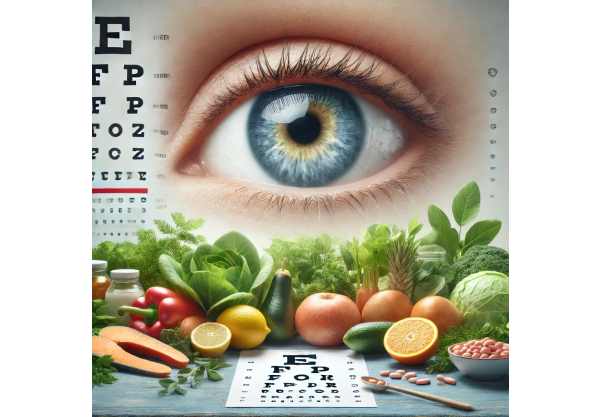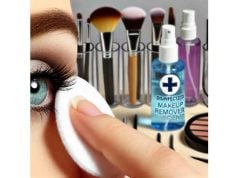
Our eyes are windows to the world, yet their care is often overlooked until problems arise. Vision is integral to our daily lives, affecting everything from our ability to work and drive to our enjoyment of hobbies and social activities. While genetic factors and aging are commonly recognized as key contributors to eye health, the role of diet in maintaining optimal vision is equally crucial and often underestimated. The foods we consume provide essential nutrients that can either support or impair eye health, influencing everything from our day-to-day visual acuity to our long-term risk of developing serious conditions like cataracts, glaucoma, and age-related macular degeneration (AMD).
As we face a growing global burden of visual impairments and blindness—many of which are preventable—understanding the impact of diet on eye health has become increasingly important. Diet not only affects overall health but also plays a specific role in the prevention and management of eye diseases. This article explores the intricate relationship between diet and eye health, highlighting the importance of specific nutrients, dietary patterns, and lifestyle choices in preserving and enhancing vision. Through a comprehensive examination of current research, we will uncover how the right diet can protect our eyes and reduce the risk of ocular diseases, providing a roadmap for maintaining healthy vision throughout our lives.
The Role of Vitamins in Maintaining Eye Health
Vitamins are essential for the proper functioning of many bodily systems, including the eyes. Certain vitamins have been identified as particularly important for maintaining eye health and preventing the onset of various eye-related conditions. Among these, vitamins A, C, E, and the B-complex vitamins stand out for their unique contributions to ocular health.
Vitamin A: Essential for Vision
Vitamin A is one of the most crucial vitamins for eye health. It plays a vital role in maintaining the health of the retina, the light-sensitive layer at the back of the eye. Vitamin A is a key component of rhodopsin, a protein in the eyes that allows us to see in low-light conditions. Without sufficient vitamin A, the eyes cannot produce enough rhodopsin, leading to night blindness and, in severe cases, total vision loss. Additionally, vitamin A helps maintain the cornea, the eye’s outermost layer, which acts as a barrier against dirt, germs, and other harmful particles.
Deficiencies in vitamin A are a leading cause of preventable blindness, particularly in developing countries. In children, a lack of vitamin A can result in xerophthalmia, a condition characterized by dryness of the conjunctiva and cornea, leading to severe vision impairment and blindness if left untreated. The importance of vitamin A in maintaining healthy vision cannot be overstated.
Foods rich in vitamin A include liver, dairy products, and beta-carotene-rich vegetables like carrots, sweet potatoes, and spinach. Beta-carotene is a precursor to vitamin A, meaning the body can convert it into the active form of the vitamin as needed. Ensuring adequate intake of these foods is crucial for maintaining eye health and preventing vitamin A deficiency-related conditions.
Vitamin C: Protecting the Eyes from Oxidative Stress
Vitamin C, also known as ascorbic acid, is a powerful antioxidant that helps protect the eyes from damage caused by free radicals—unstable molecules that can damage cells and contribute to aging and diseases. The lens of the eye, which focuses light onto the retina, relies on vitamin C to maintain its clarity and prevent the development of cataracts. Cataracts, which cause the lens to become cloudy, are a leading cause of blindness worldwide.
Research has shown that a diet high in vitamin C can reduce the risk of cataracts and slow the progression of age-related macular degeneration (AMD). AMD is a condition that affects the macula, the part of the retina responsible for central vision, and is a leading cause of vision loss in older adults. Vitamin C’s antioxidant properties help neutralize the free radicals that can damage the macula, thereby reducing the risk of AMD.
Good dietary sources of vitamin C include citrus fruits, strawberries, bell peppers, broccoli, and kale. These foods provide not only vitamin C but also other antioxidants that work synergistically to protect the eyes from oxidative damage.
Vitamin E: Another Antioxidant Powerhouse
Vitamin E is another potent antioxidant that plays a critical role in protecting the eyes from oxidative stress. It works by neutralizing free radicals that can damage cells, particularly the photoreceptor cells in the retina. These cells are essential for converting light into electrical signals that the brain can interpret as visual images.
Studies have shown that vitamin E can help prevent the onset of cataracts and slow the progression of AMD. The Age-Related Eye Disease Study (AREDS) found that a combination of vitamin E, vitamin C, beta-carotene, and zinc significantly reduced the risk of advanced AMD in individuals at high risk of the disease.
Foods rich in vitamin E include nuts, seeds, spinach, and fortified cereals. Incorporating these foods into the diet can help ensure adequate intake of this essential nutrient and provide protection against age-related eye conditions.
B-Complex Vitamins: Supporting Overall Eye Function
The B-complex vitamins, particularly vitamins B6, B9 (folate), and B12, are important for reducing the risk of age-related macular degeneration (AMD). These vitamins help lower homocysteine levels in the blood, an amino acid that is associated with inflammation and an increased risk of cardiovascular and eye diseases.
Additionally, vitamin B2 (riboflavin) is crucial for maintaining the health of the cornea and lens, helping to prevent cataracts. Riboflavin acts as an antioxidant, protecting the eyes from oxidative damage and supporting the overall health of ocular tissues.
Foods rich in B-complex vitamins include whole grains, eggs, dairy products, meat, and leafy green vegetables. A diet that includes these foods can help support overall eye health and reduce the risk of vision-related diseases.
The Influence of Minerals and Trace Elements on Eye Health
In addition to vitamins, certain minerals and trace elements play a crucial role in maintaining eye health. These nutrients are involved in various physiological processes that are essential for preserving vision and preventing eye diseases. Among the most important are zinc, selenium, and copper, each of which contributes uniquely to ocular health.
Zinc: A Critical Mineral for Vision
Zinc is an essential mineral that is particularly important for eye health. It plays a key role in the metabolism of vitamin A, enabling it to create melanin, a pigment that protects the eyes. Zinc is also found in high concentrations in the retina and helps in the production of key enzymes that are crucial for maintaining healthy eye tissue.
A deficiency in zinc can lead to poor night vision and increase the risk of developing age-related macular degeneration (AMD). Zinc deficiency is also associated with an increased risk of cataracts, a condition in which the lens of the eye becomes cloudy and impairs vision.
Foods rich in zinc include oysters, beef, pumpkin seeds, and legumes. Ensuring adequate intake of zinc is important for maintaining good vision, particularly as we age.
Selenium and Copper: Protecting the Eyes from Oxidative Stress
Selenium and copper are two trace elements that play important roles in protecting the eyes from oxidative stress. Selenium is a component of the enzyme glutathione peroxidase, which helps neutralize harmful free radicals in the lens and other parts of the eye. Research suggests that adequate selenium intake may reduce the risk of cataracts and AMD.
Copper, while needed in smaller amounts, works in conjunction with zinc and other antioxidants to protect against oxidative damage. Copper is involved in the formation of superoxide dismutase, an enzyme that helps protect cells from damage caused by free radicals. Without enough copper, the body cannot effectively use iron, which is also essential for healthy vision.
Good dietary sources of selenium include Brazil nuts, fish, eggs, and whole grains, while copper can be found in nuts, seeds, and shellfish. Including these foods in the diet can help protect the eyes from oxidative stress and reduce the risk of vision loss.
Iron: Supporting Ocular Blood Flow
Iron is another important mineral for eye health, particularly for maintaining healthy blood flow to the ocular tissues. Iron is essential for the production of hemoglobin, a protein in red blood cells that carries oxygen to the tissues, including those in the eyes. Adequate oxygenation is crucial for maintaining the health and function of the retina and other ocular structures.
Iron deficiency can lead to anemia, which in turn can cause vision problems, including retinopathy. Retinopathy is a condition in which the blood vessels in the retina become damaged, leading to vision loss. Ensuring adequate iron intake is particularly important for individuals at risk of anemia, such as women of childbearing age.
Foods rich in iron include red meat, poultry, fish, lentils, and fortified cereals. Consuming these foods in combination with vitamin C-rich foods can enhance iron absorption and support overall eye health.
The Impact of Omega-3 Fatty Acids on Eye Health
Omega-3 fatty acids, particularly eicosapentaenoic acid (EPA) and docosahexaenoic acid (DHA), are essential fats that play a critical role in maintaining eye health. These fatty acids are important components of the retina and have been shown to reduce the risk of dry eye syndrome, age-related macular degeneration (AMD), and other ocular conditions.
DHA: Vital for Retinal Health
DHA is a major structural component of the retina, and adequate levels are necessary for maintaining its function. Studies suggest that DHA may protect against retinal degeneration and support overall visual development, particularly in infants. A deficiency in DHA can impair vision and increase the risk of AMD and other retinal disorders.
The best sources of DHA are fatty fish like salmon, mackerel, and sardines, as well as fish oil supplements. For those who do not consume fish, algae-based DHA supplements are a suitable alternative. Ensuring adequate intake of DHA is important for maintaining retinal health and preventing age-related vision problems.
EPA: Reducing Inflammation and Protecting Vision
EPA, another crucial omega-3 fatty acid, is known for its potent anti-inflammatory properties. Inflammation is a significant factor in the development of many eye conditions, including dry eye syndrome and age-related macular degeneration (AMD). By reducing inflammation, EPA helps protect the eyes from these conditions and supports overall ocular health.
Inflammation in the eyes can lead to the breakdown of ocular tissues, contributing to the progression of AMD and other degenerative eye diseases. Studies have shown that higher dietary intake of EPA, often through the consumption of fatty fish or fish oil supplements, is associated with a reduced risk of these conditions. Additionally, EPA is beneficial in managing dry eye syndrome, a condition that affects millions of people worldwide and is characterized by insufficient tear production or poor-quality tears.
To ensure adequate intake of EPA, it is recommended to consume fatty fish, such as salmon, mackerel, and sardines, at least twice a week. For individuals who do not eat fish, fish oil supplements or plant-based omega-3 sources like flaxseeds and chia seeds can be used to boost EPA levels.
Omega-3s and Dry Eye Syndrome: Relief and Prevention
Dry eye syndrome is a common and often chronic condition where the eyes do not produce enough tears or the tears evaporate too quickly. This can lead to discomfort, irritation, and blurred vision. Omega-3 fatty acids, particularly EPA and DHA, have been shown to improve tear production and reduce the symptoms of dry eye syndrome.
The anti-inflammatory effects of omega-3s play a critical role in managing this condition. By reducing inflammation in the tear glands and ocular surface, omega-3s help improve the quality and quantity of tears, providing relief from the symptoms of dry eye syndrome. Regular consumption of omega-3-rich foods or supplements can lead to significant improvements in eye moisture and overall comfort.
For those suffering from dry eye syndrome, incorporating omega-3-rich foods into the diet, such as fish, flaxseeds, walnuts, and chia seeds, can be a natural and effective way to alleviate symptoms. Additionally, omega-3 supplements are widely available and can be an alternative for those who have dietary restrictions or prefer not to consume fish.
Balancing Omega-3 and Omega-6 Fatty Acids
While omega-3 fatty acids are beneficial for eye health, it is also important to maintain a proper balance between omega-3 and omega-6 fatty acids in the diet. Omega-6 fatty acids, found in many vegetable oils and processed foods, are also essential for health, but they can promote inflammation when consumed in excess.
In modern diets, there is often an imbalance with a higher intake of omega-6 compared to omega-3 fatty acids, which can exacerbate inflammatory conditions, including those affecting the eyes. To support optimal eye health, it is crucial to increase the intake of omega-3s while moderating the consumption of omega-6-rich foods. This balance can help reduce the risk of inflammatory eye conditions and support overall ocular health.
Antioxidants and Their Role in Eye Health
Antioxidants are compounds that protect the body’s cells from damage caused by oxidative stress, which occurs when there is an imbalance between free radicals and antioxidants in the body. The eyes are particularly vulnerable to oxidative stress due to their exposure to light and oxygen, making antioxidants essential for protecting vision and preventing eye diseases.
Lutein and Zeaxanthin: Protecting the Retina
Lutein and zeaxanthin are two powerful antioxidants that are highly concentrated in the retina, particularly in the macula, which is responsible for central vision. These carotenoids act as natural filters, absorbing harmful blue light and protecting the eyes from oxidative damage.
Studies have shown that higher dietary intake of lutein and zeaxanthin is associated with a lower risk of developing age-related macular degeneration (AMD) and cataracts. These antioxidants also play a role in improving visual performance, particularly in low-light conditions, and reducing glare sensitivity.
Leafy green vegetables like kale, spinach, and collard greens are among the best dietary sources of lutein and zeaxanthin. Other sources include eggs, corn, and orange and yellow fruits and vegetables. Incorporating these foods into the diet can help maintain the health of the retina and reduce the risk of age-related eye diseases.
Vitamin C and Vitamin E: The Dynamic Duo
Vitamin C and vitamin E are two of the most well-known antioxidants, and they work together to protect the eyes from oxidative damage. As mentioned earlier, vitamin C helps maintain the clarity of the lens and reduces the risk of cataracts. Vitamin E, on the other hand, protects the photoreceptor cells in the retina from damage caused by free radicals.
The combination of vitamin C and vitamin E has been shown to be particularly effective in slowing the progression of age-related macular degeneration (AMD). The AREDS study highlighted the benefits of a supplement regimen that included both vitamins, along with beta-carotene and zinc, in reducing the risk of advanced AMD.
To ensure adequate intake of these antioxidants, it is important to include a variety of fruits, vegetables, nuts, and seeds in the diet. Citrus fruits, strawberries, bell peppers, almonds, and sunflower seeds are excellent sources of vitamin C and vitamin E, respectively.
Other Antioxidants: Selenium, Beta-Carotene, and Beyond
In addition to lutein, zeaxanthin, vitamin C, and vitamin E, other antioxidants like selenium and beta-carotene also play important roles in eye health. Selenium, as mentioned earlier, supports the antioxidant defense system in the eyes, helping to protect against oxidative damage. Beta-carotene, a precursor to vitamin A, is crucial for maintaining the health of the retina and supporting night vision.
Including a variety of antioxidant-rich foods in the diet can provide comprehensive protection for the eyes. This can be achieved by consuming a colorful array of fruits and vegetables, which are rich in various antioxidants that work together to support ocular health and prevent age-related vision loss.
The Importance of Hydration for Eye Health
While the role of diet in eye health often focuses on specific nutrients, hydration is another key factor that is sometimes overlooked. Proper hydration is essential for maintaining the health of the eyes, particularly the tear film that keeps the eyes moist and comfortable.
The Tear Film: A Critical Component of Eye Health
The tear film is a thin layer of fluid that covers the surface of the eye, providing lubrication, protecting against infection, and ensuring clear vision. It is composed of three layers: an oily layer that prevents evaporation, a watery layer that provides moisture, and a mucous layer that helps the tear film adhere to the eye’s surface.
Dehydration can affect the production and quality of the tear film, leading to dry eye syndrome and discomfort. When the body is dehydrated, it conserves water for essential bodily functions, often at the expense of tear production. This can result in insufficient tear production or tears that evaporate too quickly, causing dryness, irritation, and blurred vision.
To maintain a healthy tear film, it is important to stay hydrated by drinking adequate amounts of water throughout the day. The general recommendation is to drink at least eight 8-ounce glasses of water daily, though individual needs may vary based on factors such as climate, activity level, and overall health.
Hydrating Foods: Supporting Eye Health from the Inside Out
In addition to drinking water, consuming hydrating foods can also support eye health. Fruits and vegetables with high water content, such as cucumbers, watermelon, oranges, and strawberries, can contribute to overall hydration and help maintain the moisture balance in the eyes.
These foods not only provide hydration but also deliver essential vitamins and antioxidants that support eye health. For example, watermelon is rich in vitamin A, while oranges provide a good source of vitamin C—both of which are important for maintaining healthy vision.
Avoiding Dehydrating Substances
It is also important to be mindful of substances that can contribute to dehydration, such as caffeine and alcohol. These substances can have a diuretic effect, leading to increased urine production and fluid loss. While moderate consumption may not pose significant risks, excessive intake can contribute to dehydration and exacerbate dry eye symptoms.
For those who consume caffeinated beverages or alcohol, it is important to balance intake with adequate water consumption to maintain proper hydration and support eye health.










